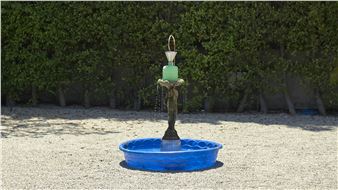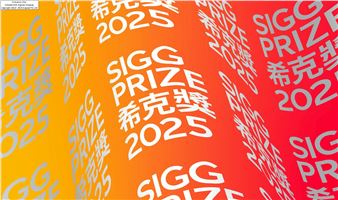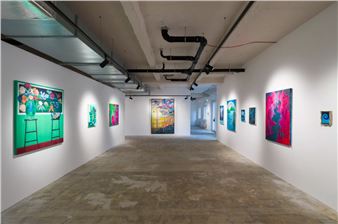Claudia & Julia MГјller: Umkehrschub
Maccarone is pleased to present its second exhibition with the Swiss-born artists Claudia & Julia MГјller, following their New York debut at the gallery in 2002. Umkehrschub features two large-scale wall drawings, an iconic part of the MГјller sistersвҖҷ collaborative practice for over a decade, along with an arrangement of ceramic vessels from the last year and a set of 12 new silkscreen monoprint-on-canvas works.
With each of these works, the artists employ various processes ofvtranslation (statue becomes drawing; ceramic becomes canvas; print becomes painting) to create an oscillation between the static and dynamic. The artists characterize this energy shift with the aeronautics term umkehrschub, which refers to the reverse thrust of engine exhaust used to decelerate an aircraft during landing. Here, umkehrschub вҖ” in this case, the reversal of the energy of an image, material, or signifier вҖ” is an analytic tool by which the quotidian takes on new meaning and our understanding of images is altered.
While three-dimensional objects have frequently accompanied the sistersвҖҷ wall drawing installations, these new ceramics extend the notion of painting toward new surfaces вҖ” allowing them to use ceramic as canvas. Called вҖңBlind Paintings,вҖқ these vessels manifest the artistsвҖҷ embrace of a spirit of unpredictability. They nod to the process of painting and the intrinsically experimental nature of the method (whether it is strokes on a canvas or hands shaping clay). With these playful gestures, the artists point to artmaking as a kind of performance and to the potter as improvisationist.
The ceramics are indelibly shaped by their relationship with the wall drawing, which is populated by black-and-white renderings of classical statuary that float larger than life on the gallery walls. In the canvas works, too, photographs of nudes are adhered to the surface, mirroring the same dialogue that exists between the ceramic vessels and the wall drawing. The artistsвҖҷ essentially dialogic technique utilizes poetic juxtaposition as a means of shifting our understanding of imagesвҖҷ meanings. The interplay between the artworks in the space is not unlike the collaborative practice itself вҖ” two entities coming together to create something new.

Recommended for you
Maccarone is pleased to present its second exhibition with the Swiss-born artists Claudia & Julia MГјller, following their New York debut at the gallery in 2002. Umkehrschub features two large-scale wall drawings, an iconic part of the MГјller sistersвҖҷ collaborative practice for over a decade, along with an arrangement of ceramic vessels from the last year and a set of 12 new silkscreen monoprint-on-canvas works.
With each of these works, the artists employ various processes ofvtranslation (statue becomes drawing; ceramic becomes canvas; print becomes painting) to create an oscillation between the static and dynamic. The artists characterize this energy shift with the aeronautics term umkehrschub, which refers to the reverse thrust of engine exhaust used to decelerate an aircraft during landing. Here, umkehrschub вҖ” in this case, the reversal of the energy of an image, material, or signifier вҖ” is an analytic tool by which the quotidian takes on new meaning and our understanding of images is altered.
While three-dimensional objects have frequently accompanied the sistersвҖҷ wall drawing installations, these new ceramics extend the notion of painting toward new surfaces вҖ” allowing them to use ceramic as canvas. Called вҖңBlind Paintings,вҖқ these vessels manifest the artistsвҖҷ embrace of a spirit of unpredictability. They nod to the process of painting and the intrinsically experimental nature of the method (whether it is strokes on a canvas or hands shaping clay). With these playful gestures, the artists point to artmaking as a kind of performance and to the potter as improvisationist.
The ceramics are indelibly shaped by their relationship with the wall drawing, which is populated by black-and-white renderings of classical statuary that float larger than life on the gallery walls. In the canvas works, too, photographs of nudes are adhered to the surface, mirroring the same dialogue that exists between the ceramic vessels and the wall drawing. The artistsвҖҷ essentially dialogic technique utilizes poetic juxtaposition as a means of shifting our understanding of imagesвҖҷ meanings. The interplay between the artworks in the space is not unlike the collaborative practice itself вҖ” two entities coming together to create something new.
Artists on show
Contact details


 ARTISTS
ARTISTS











